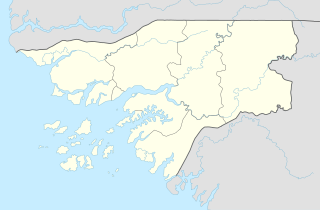Bissau
| Bissau | |||
|---|---|---|---|

Downtown Bissau
|
|||
|
|||
| Location of Bissau in Guinea-Bissau | |||
| Coordinates: 11°51′N 15°34′W / 11.850°N 15.567°WCoordinates: 11°51′N 15°34′W / 11.850°N 15.567°W | |||
| Country |
|
||
| Region | Bissau Autonomous Sector | ||
| Founded | 1687 | ||
| Area | |||
| • Total | 77.5 km2 (29.9 sq mi) | ||
| Elevation | 0 m (0 ft) | ||
| Population (2010 est.) | |||
| • Total | 395,954 | ||
| • Density | 5,100/km2 (13,000/sq mi) | ||
| ISO 3166 code | GW-BS | ||
Bissau is the capital city of Guinea-Bissau. In 2007 Bissau had an estimated population of 407,424. Bissau is located on the Geba River estuary, off the Atlantic Ocean, and is Guinea-Bissau's largest city, major port, and its administrative and military centre.
The city was founded in 1687 by Portugal as a fortified port and trading center. In 1942 it became the capital of Portuguese Guinea.
After the declaration of independence by the anti-colonial guerrillas of PAIGC in 1973, the capital of the de facto independent territories was declared to be Madina do Boe. Bissau remained as the capital of the Portuguese-occupied regions, and the de jure capital of all of Portuguese Guinea. When Portugal recognized the independence of Guinea-Bissau and decolonised in 1974 due to the military coup of April 25 in Lisbon, the two territories merged and Bissau became the capital of the new independent state. The city is known for its annual carnival.
The city, as the seat of government, was the scene of intense fighting during the beginning and end of the Guinea-Bissau Civil War in 1998 and 1999.
Bissau is located at 11°52' North, 15°36' West (11.86667, -15.60) [1], on the Geba River estuary, off the Atlantic Ocean. The land surrounding Bissau is extremely low-lying, and the river is accessible to ocean-going vessels despite its modest discharge for about 80 kilometres (50 mi) beyond the city.
Bissau has a tropical savanna climate (Köppen Aw), not quite wet enough to qualify as a tropical monsoon climate (Am) but much wetter than most climates of its type. Almost no rain falls from November to May, but during the remaining five months of the year the city receives around 2,020 millimetres (80 in) of rain. During the wet season and even during the three months beforehand, high humidity makes heat discomfort extreme.
...
Wikipedia



